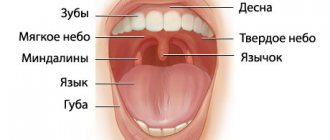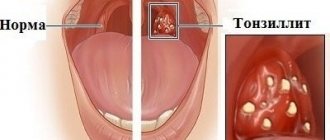Exacerbation of chronic tonsillitis: symptoms
Often, for a long time, chronic tonsillitis occurs without symptoms or has scanty symptoms (in a simple form). There may be discomfort when swallowing food and liquids, a sensation of a foreign body in the throat, dry mouth, halitosis (bad odor) and tingling. Externally, the tonsils increase in size and there are signs of inflammation. The disease is characterized by exacerbations of sore throats up to three times a year, long periods of recovery, with general symptoms of asthenia and prolonged low-grade fever.
For the toxic-allergic form, more frequent exacerbations are typical, often with complications in the area of neighboring tissues (pharyngitis, peritonsillar abscesses), and the almost constant presence of asthenia and prolonged fever are typical.
The clinical picture of chronic tonsillitis during an exacerbation is as follows:
- sore throat that gets worse when swallowing;
- redness of the throat and tonsils;
- characteristic plaque;
- purulent discharge from the tonsils;
- bad breath;
- swelling of the nasopharynx;
- temperature increase;
- weakness;
- headache;
- fast fatiguability;
- arrhythmia;
- enlarged lymph nodes;
- dyspnea.
Causes of bad breath
Medical statistics provide the following data: eighty percent of diseases that cause bad breath are associated with dental problems. And only twenty percent of cases occur due to diseases of other human organs and systems, as well as other causes.
Among the dental causes can be identified: caries, gingivitis, stomatitis, periodontitis, periodontal disease, tartar, etc. In this case, the source of strong bad breath is bacteria that have taken up residence in the oral cavity and are active. They are the ones who release substances that emit an unpleasant odor. In this case, treatment of the oral cavity must be carried out by a dentist.
Severe halitosis can also be caused by:
- poor oral hygiene. Even if the teeth and gums are healthy (although poor hygiene is the first step on the way to the dental chair), irregular or improper brushing of teeth can be a direct cause of halitosis;
- eating certain foods, for example, onions or garlic (halitosis in this case is a temporary phenomenon that does not require treatment);
- diseases of the gastrointestinal tract - most of these diseases contribute to increased activation of bacteria that cause bad breath;
- diseases of the lower respiratory tract: tuberculosis, pneumonia, bronchitis, lung cancer, etc.;
- diabetes;
- smoking and alcohol abuse - in this case, the cause of halitosis is the toxic compounds that are part of these products. These substances settle in the body and emit an unpleasant odor;
- diseases of the ENT organs (chronic tonsillitis, sinusitis, postnasal drip, rhinitis) - the strong odor in this case will disappear after proper treatment by an otolaryngologist.
Let's look at the last reason in more detail.
Causes, main risk factors
Up to 30 different colonies of pathogenic microbes can be sown on the surface of the tonsils of patients suffering from chronic tonsillitis. But in crypts and lacunae staphylo- or streptococcus is usually determined. A key role in the pathogenesis of chronic tonsillitis is played by beta-hemolytic strains of streptococcus (type A). Other flora - gram-negative coccal, fungal, viral - have an impact on local immunity, they support inflammation.
There are a number of factors contributing to the occurrence of the disease:
- hypothermia;
- decreased immunity;
- microtrauma of the tonsils;
- foci of inflammation in the mouth and in the head area (caries, sinusitis, adenoids, etc.);
- smoking;
- poor nutrition;
- allergy.
Viruses and bacteria that cause tonsillitis can come from the external environment.
Treatment of chronic tonsillitis without surgery
Despite the wide market of medical services, there are not so many effective conservative methods of treating chronic tonsillitis. The fact is that in modern otorhinolaryngology it is customary to divide the mucous membrane into fragments, there are doctors who deal only with diseases of the nose - rhinologists, there are specialists who deal only with the treatment of the throat. In fact, the entire area of the mucous membrane lining the upper respiratory tract is one organ.
Session of deep vacuum ultrasonic sanitation of palatine tonsils with ozonated solution
We are forced to obtain oxygen from the air, and the air is not sterile; the respiratory organs, like no other system of our body, experience a colossal biological load and are constantly in contact with microbes. The anatomical structure of the upper respiratory tract is the product of a long period of evolution. The upper respiratory tract is a complex mechanism created by nature with one purpose: to be a protective barrier. Moreover, many ENT diseases (adenoids, vasomotor rhinitis, sinusitis, chronic pharyngitis), which are classified as different and treated in different ways, are essentially one disease in different stages of development, so to speak, a “machine” in different stages of breakdown.
Video: treatment of chronic tonsillitis
So, the essence of many inflammatory ENT diseases, including chronic tonsillitis, is a degenerative process in the mucous membrane, caused by the microbes that we breathe, as a result of the weakening of the protective properties of the mucous membrane. It follows from this that when doing treatment you need to influence the entire area of the mucous membrane of the upper respiratory tract, you just need to take into account some anatomical features - such as the structure of the palatine tonsils, and taking these features into account, locally enhance the therapeutic effect. Since the palatine tonsils are essentially the same mucous membrane only folded into an accordion, washing the tonsils should be an integral part of the treatment process.
Conducting a photodynamic therapy session on the pharynx area for chronic tonsillitis
The lack of effective methods for treating chronic tonsillitis is also due to the fact that there are a number of dogmas in modern medicine. One of them is that the most common way to fight germs today is with antibiotics. Antibiotics, unfortunately, do not penetrate well into the upper layers of the degenerative mucous membrane; moreover, they do not restore it. With chronic inflammation, the regeneration of the mucous membrane is disrupted and microerosions form on it. Figuratively speaking, the mucous membrane becomes like a “sieve,” which is the most important basis for the inflammatory process.
Stimulation of reflexogenic zones in chronic tonsillitis
Taking into account the above, the main task of treating chronic tonsillitis is to influence all parts of the pathogenesis of the disease, therefore the following methods are used in our clinic:
| Cleansing tonsils with ozonized solution | In our clinic, we wash the palatine tonsils using the tonsillor apparatus with an ozonated solution, which is by far the most effective way to cleanse the entire thickness of the tonsils from pathological contents. |
| Sanitation of mucous membranes with mineral salts | In our clinic, we irrigate the entire mucous membrane with a solution of individually selected mineral salts, which sanitize the mucous membrane and restore it, which cannot be achieved with modern antibiotics. We also activate mucosal regeneration using photodynamic therapy. Lymph stasis plays an important role in the pathogenesis of inflammation, including chronic tonsillitis. Activation of lymph flow in the area of inflammation plays an important role: this is how the “soldiers” of our immunity - lymphocytes - move along with lymph. |
| Stimulation of reflexogenic zones | With the help of injections into the reflexogenic zone of the neck, ozone causes a spasm of the subcutaneous lymphatic vessels, which activates the lymph flow in the pharynx, leading to rapid stabilization of the immune system. The integrated approach we use affects all parts of the pathogenesis of chronic tonsillitis, which allows it to be treated conservatively, avoiding surgical treatment. |
Classification
Doctors distinguish various clinical forms of chronic tonsillitis, differing in clinical manifestations, severity of the condition and prognosis, risk of complications, as well as treatment tactics.
The simple form of chronic tonsillitis is characterized by a predominance of local symptoms. If general manifestations and lymphadenitis occur, this is referred to as a toxic-allergic form of tonsillitis. It comes in two versions:
Toxic-allergic chronic tonsillitis 1st degree . Sore throats are typical for him, which can worsen after ARVI, combined with general symptoms.
Toxic-allergic chronic tonsillitis of the 2nd degree - the symptoms are more pronounced, associated with diseases that have common factors of etiology and pathogenesis.
According to the degree of compensation of the process, the disease is divided into two options:
- chronic tonsillitis, compensated form - the source of infection is in a dormant state, there are no reactions from the body, repeated sore throats do not occur; The function of the tonsils and general reactivity are not impaired.
- chronic tonsillitis is a decompensated form - relapses of sore throat occur, complications of the heart, damage to the paranasal sinuses, middle ear, and renal complications are possible.
According to pathomorphological criteria, the process is divided into the following options:
- lacunar tonsillitis with predominant damage to the area of the lacunae;
- parenchymal-lacunar, involving in addition to the lacunae also the area of the lymphoid tissue of the tonsils themselves;
- phlegmonous - inflammation is predominantly localized in the area of lymphoid tissue;
- sclerotic with abundant growth of connective tissue fibers in the area of the tonsils and surrounding tissue.
All about tonsillitis
Tonsillitis
Tonsillitis is an inflammation of the pharyngeal and palatine tonsils at the back of the throat. This disease mainly affects children, but both teenagers and adults can get it.
Symptoms
Tonsillitis can feel like a bad cold or flu, and the tonsils at the back of your throat will be red and swollen.
The main symptoms in children and adults are:
- a sore throat
- problems with swallowing
- high temperature 38°C or higher
- cough
- headache
- feeling of nausea
- ear pain
- feeling tired
Sometimes symptoms can be more severe and include:
- Swollen lymph nodes in the neck (feels like a lump on the side of the neck)
- white pus-filled spots on your tonsils
- bad breath
Causes
Viral infections cause 40 to 60% of tonsillitis cases. Many viruses can cause inflammation of the tonsils (and the rest of the throat), including adenovirus, rhinovirus, coronavirus, influenza virus, parainfluenza virus, coxsackie virus, measles virus, Epstein-Barr virus, cytomegalovirus, respiratory syncytial virus, and herpes simplex virus. Tonsillitis may also be part of the initial reaction to HIV infection. It is estimated that 1 to 10% of cases are caused by the Epstein-Barr virus.
Tonsillitis can also be caused by infection with bacteria, primarily group A β-hemolytic streptococci (GABHS), which cause a sore throat. A bacterial infection of the tonsils usually follows an initial viral infection. When tonsillitis recurs after antibiotic treatment for streptococcal bacteria, it is usually due to the same bacteria as the first time, indicating that the antibiotic treatment was not completely effective.
Inside the tonsils, white blood cells from the immune system destroy viruses or bacteria by producing inflammatory cytokines, which also lead to fever. The infection may also be present in the throat and surrounding areas, causing inflammation of the pharynx.
Diagnostics
There is no clear distinction between a sore throat that is specific to tonsillitis and a sore throat caused by inflammation in both the tonsils and nearby tissues. Acute sore throat may be diagnosed as tonsillitis, pharyngitis, or tonsillopharyngitis (also called pharyngotonsillitis), depending on clinical findings.
Throat swab.
In primary care settings, the Centor criteria are used to determine the likelihood of group A beta-hemolytic streptococcus (GABHS) infection in acute tonsillitis and the need for antibiotics to treat tonsillitis
If the rapid test for streptococcus is negative, a bacterial culture may be required.
Nasoendoscopy may be used for those with severe neck pain and inability to swallow any liquids to rule out occult epiglottis and supraglottis. Conventional nasoendoscopy is not recommended for children.
Treatment
Treatments to reduce discomfort from tonsillitis include:
- pain relievers and fever reducers such as paracetamol (acetaminophen) and ibuprofen
- rinse with warm salt water, lozenges, honey or warm liquids
Antibiotics
If tonsillitis is caused by group A streptococcus, antibiotics are helpful, with penicillin or amoxicillin being the main choices.
Cephalosporins and macrolides are considered good alternatives to penicillin in the emergency setting. A macrolide, such as azithromycin or erythromycin, is used for people who are allergic to penicillin. If penicillin therapy does not help, bacterial tonsillitis may respond to treatments that are effective against beta-lactamase-producing bacteria, such as clindamycin or amoxicillin-clavulanate. Treatment with antibiotics is usually carried out for seven to ten days.
Painkillers
Paracetamol and non-steroidal anti-inflammatory drugs (NSAIDs) can be used to treat sore throat in children and adults. NSAIDs (such as ibuprofen) and opioids (such as codeine and tramadol) are equally effective for pain relief, but precautions should be taken with these pain medications. NSAIDs can cause peptic ulcers and kidney damage. An anesthetic mouth rinse may also be used to relieve symptoms.
Surgery
When tonsillitis recurs frequently, at least five times a year, or when the tonsils become so swollen that swallowing is difficult and painful, a tonsillectomy may be performed to surgically remove the tonsils.
Prevention
The microbes that cause viral and bacterial tonsillitis are contagious. Therefore, the best prevention is to follow the rules of hygiene.
- Wash your hands thoroughly and often, especially after using the toilet and before eating
- Avoid sharing food, drinking glasses, water bottles, or utensils
- Change your toothbrush after you are diagnosed with tonsillitis
Sources
" Tonsillitis " , UK National Health Service
https://www.nhs.uk/conditions/tonsillitis/
"Tonsillopharyngitis" , World Medical Directory "The Merck Manuals",
https://www.msdmanuals.com/professional/ear,-nose,-and-throat-disorders/oral-and-pharyngeal-disorders/tonsillopharyngitis?query=tonsillitis
"Tonsillitis" , Mayo Foundation for Medical Education and Research (MFMER).
https://www.mayoclinic.org/diseases-conditions/tonsillitis/symptoms-causes/syc-20378479
Complications of chronic tonsillitis
Against the background of a chronic inflammatory process in the tonsil area, various complications are possible. Therefore, it is important to know why chronic tonsillitis is dangerous. Thus, the tonsils themselves, losing their function as a barrier to infection, become its breeding ground. Inside them are pathogens with the products of their metabolism. The infection can spread throughout organs and tissues, affecting the renal parenchyma, joint and heart tissue, and liver. In addition, tonsillitis adversely affects the functioning of the immune system and can be a provocateur of collagen diseases - lupus, scleroderma, dermatomyositis, periarteritis. The skin and peripheral nerve fibers may also be affected. With prolonged intoxication against the background of the disease, damage to blood vessels (vasculitis) and platelets (purpura) is possible.
Why do we get chronic tonsillitis?
The main causes of the development of chronic tonsillitis are inflammation of the tonsils and ongoing tonsil reactions, which can be caused by long-term exposure to an infectious factor.
In the photo - lymphopharyngeal ring
During the development of chronic tonsillitis, the overall level of the body’s immunity is of no small importance.
Diagnostics
Diagnosis of chronic tonsillitis occurs on the basis of complaints, examination of the patient, and questioning of the patient. Objective signs, manifestations of chronic tonsillitis, and the general condition of the tonsils are important; the doctor determines the stages of the process and the form.
The following diagnostic procedures are also carried out:
- throat swab for flora;
- general blood and urine tests;
- blood test for antibodies to streptococcus.
This helps determine treatments for chronic tonsillitis.
How to identify chronic tonsillitis
Diagnosis of chronic tonsillitis does not present any particular difficulties for an experienced otolaryngologist. The patient's medical history and complaints are of utmost importance in diagnosis; as a rule, the history includes previous sore throats and complaints of frequent pain and discomfort in the throat.
Examination of the throat for chronic tonsillitis
During mesopharyngoscopy (examination of the pharynx) for chronic tonsillitis, the following signs are present: hyperemia and roller-like thickening of the edges of the palatine arches; cicatricial adhesions between the tonsils and palatine arches; loosened or scarred and hardened tonsils; caseous-purulent plugs or liquid pus in the lacunae of the tonsils.
Treatment methods in adults
In most cases, they resort to conservative treatment of chronic tonsillitis. Source: Modern methods of treating chronic tonsillitis. Ryazantsev S.V., Eremina N.V., Shcherban K.Yu. Medical Council, 2022. p. 68-72:
- therapy for inflammation in the head and oral cavity;
- procedures that increase immunity (hardening, taking vitamins, physical education, etc.);
- hyposensitizing drugs (to suppress allergic reactions);
- immunomodulators (normalize the immune system);
- means of reflex action (acupuncture, manual therapy);
- washing the tonsils with antiseptics;
- administration of drugs to the tonsils.
The treatment plan is complemented by physical therapy for chronic tonsillitis.
A radical method of treating chronic tonsillitis is surgical removal of the tonsils (tonsillectomy). The operation is performed in cases where inflammation occurs more than five times a year and does not respond to complex conservative treatment of chronic tonsillitis. Source: Choosing an antibiotic for exacerbation of tonsillitis. Karpishchenko S.A., Kolesnikova O.M. Medical Council, 2015. p. 40-43.
What is the reason for this difference in approaches in the practice of Russian doctors and their colleagues from other countries?
First of all, the criteria on the basis of which the diagnosis of chronic tonsillitis is made are very different. In Russian medical practice, this diagnosis is often made based on an examination of the throat, even without assessing the patient’s history. In the practice of doctors from European countries, Japan, and the USA, such a diagnosis is rarely made, and based on a number of signs.
Patients who have been diagnosed with this can often hear about a “locus of chronic infection”, the risk of developing other diseases due to the fact that dangerous bacteria spread from the palatine tonsils to other organs and systems. Today this medical concept is outdated. Numerous studies and meta-studies have shown that only one disease has a risk of spreading beyond the tonsils - tonsillitis or, in scientific terms, “streptococcal acute tonsillitis”.
Sore throat is a disease caused by certain bacteria that are easily transmitted from person to person. If a patient suffers from tonsillitis more than 2-3 times a year for several years, the tonsils need to be removed. This is the only measure that, from the standpoint of modern science, can help the patient in this situation and negate the risks of developing other diseases.
Rinsing the tonsils does not reduce the risk of developing tonsillitis.
Prevention of chronic tonsillitis in adults
Preventive measures to prevent chronic tonsillitis include:
- proper hygiene;
- hardening;
- balanced diet;
- maintaining cleanliness in the home and workplace, eliminating dust;
- timely treatment of inflammationSource: Treatment and prevention of chronic tonsillitis. Atagulova G. Zh. Medicine and ecology, 2012.
Chronic tonsillitis is a very common disease that causes a lot of inconvenience to the patient. But is it possible to cure chronic tonsillitis? If your tonsils often become inflamed, then do not self-medicate, but consult a doctor who will select the optimal treatment regimen for you and determine how to get rid of chronic tonsillitis. You can make an appointment with a medical specialist in St. Petersburg by calling the phone number listed on the website.
Article sources:
- Treatment and prevention of chronic tonsillitis. Atagulova G. Zh. Medicine and ecology, 2012
- Chronic tonsillitis in the practice of an otolaryngologist and cardiologist. Yalymova D.L., Kostyuk V.N., Vishnyakov V.V., Yalymov A.A., Shekhyan G.G., Zadionchenko V.S. Cardio Somatics, 2014. p. 60-65
- Choice of antibiotic for exacerbation of tonsillitis. Karpishchenko S.A., Kolesnikova O.M. Medical Council, 2015. p. 40-43
- Modern methods of treating chronic tonsillitis. Ryazantsev S.V., Eremina N.V., Shcherban K.Yu. Medical Council, 2022. p. 68-72
Surgical treatment of chronic tonsillitis
The whole variety of methods for treating chronic tonsillitis is divided into two large groups: surgical methods and conservative ones. Let us dwell in detail on surgical treatment. A radical surgical method is tonsillectomy - removal of the organ along with the capsule should not be confused with tonsillotomy, which is often done in childhood.
Video: tonsillectomy - removal of tonsils
With tonsillotomy, unlike tonsillectomy, not the entire organ is removed, but only a fragment of the hypertrophied parenchyma of the pharyngeal surface of the tonsil. It is necessary to resort to tonsillectomy in extreme cases; for this there must be compelling indications, such as a complicated advanced form of the disease, despite the fact that all possible methods of conservative treatment have been exhausted. Despite these “canons” that have been established for many years, removal of tonsils is often resorted to due to the lack of availability of conservative treatment, and sometimes due to the banal lack of a competent specialist dealing with this issue.
The function of the palatine tonsils is extremely important - it is an element of the pharynx, after the removal of these organs, areas of the pharynx that were covered by these formations begin to be subject to irritation by air and food masses, is this good or bad? Apparently this is bad, since nature, as a result of a long process of evolution, did not give us a single extra organ.
Preparation of an ozonized solution for a session of deep vacuum ultrasonic sanitation of the palatine tonsils
Often, tonsils are removed from patients who have not even had a history of sore throat, and whose only complaint was caseous plugs in the throat and bad breath. The long-term result of operations to remove palatine tonsils is often severe sore throat and the development of atrophic pharyngitis, which is difficult to treat.
Conservative methods of treating chronic tonsillitis include various methods of washing the tonsils. Comprehensive information about this manipulation is presented in the article washing the tonsils.
Tonsillitis: signs of the disease
To understand the nature of the appearance of severe bad breath due to inflammation of the mucous membrane of the pharynx, you should know how the disease develops. As a result of inflammation of the tonsil gland (palatine or pharyngeal tonsils), a person is overcome by either acute tonsillitis - that is, tonsillitis , or after a long course of the acute phase of the disease with a number of complications chronic tonsillitis . The latter can develop after suffering acute diseases such as diphtheria, measles or scarlet fever.
To understand the process of the occurrence of unpleasant odor emanating from the oral cavity, it is worth familiarizing yourself with the principle of operation of the tonsils and finding out why they become inflamed. The tonsils take on part of the work of the immune system: in combination with other lymphoid formations, they protect against pathogenic microorganisms that enter the human body through airborne droplets. Depending on the general state of the immune system, the tonsils may not cope with their main function - to protect the body from infection, as a result of which tonsillitis occurs.
Having fallen ill with one of the forms of tonsillitis, inflammatory processes in the tonsil area will make themselves felt with a noticeable local symptom: first of all, the patient will feel pain in the palatine part of the mouth . The disease also has another unpleasant symptom: with tonsillitis, a bad breath appears that resembles the smell of pus. That is why the most common complaints from patients in this regard are as follows: “sore throat, bad breath.”
How to determine that a patient has tonsillitis?
- smell of pus from the mouth;
- acute pain when swallowing saliva, most often in the morning;
- cough that makes itself felt in attacks;
- a feeling that there is something in the throat;
- general malaise;
- headaches, neck or ear pain;
- increased sweating;
- increase in temperature at night;
- white clots on the tonsils.









